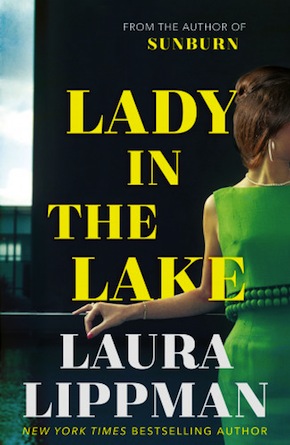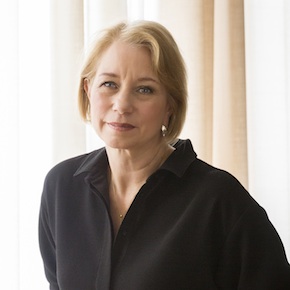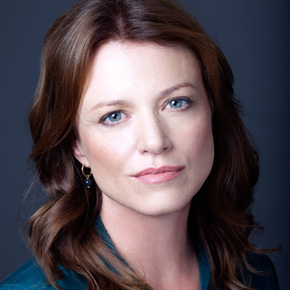Laura Lippman: From all sides
by Karin Salvalaggio
“Haunting… extraordinary.” Stephen King
Set in mid-1960s Baltimore, Laura Lippman’s latest standalone Lady in the Lake is a compassionate snapshot of a city in cultural and political flux. Though most of the focus is on Maddie Schwartz’s transformation from a Jewish housewife living in an upscale neighbourhood to a hardened newspaper reporter residing in a downtown flat, Lippman constantly shifts the point of view to the various characters Maddie encounters along the way. Seen from every possible angle; the people, their stories, and the city itself comes alive. Uniquely, it is a crime novel that gives the murder victim, an African-American woman named Cleo Sherwood, not only a fleshed-out backstory but also a voice. It is a compelling read that stays with the reader long after the final page is turned.
KS: Cleo Sherwood’s ghost addresses Maddie in the opening chapter, her voice tinged with resentment. They both come from Baltimore but have lived very different lives. Though they are equally beautiful, they’re not equal. As a black woman, Cleo wasn’t afforded the same opportunities as Maddie. From the outset, Cleo sees Maddie as a schemer. She sees how Maddie played the game and won and is inspired to do the same. Cleo doesn’t seem at all pleased when Maddie changes the rules and starts investigating her murder: “You weren’t interested in my life, you were interested in my death, and they’re not the same thing.” The victim is often overlooked both in crime fiction and in real life. Why did you feel it important to give Cleo such a prominent voice?
LL: For crime writers, I think one of the biggest, most important challenges is to make sure that our victims are fully rounded characters, not just MacGuffins that set up the story. Lady is actually about this very issue – is Maddie interested in the living Cleo or the dead one? I realised pretty early in the writing that Cleo’s voice must bookend the book, that the reader needed to be reminded that it’s her life, her story.
It started with my desire to be outside Maddie’s POV, to see what others saw: wouldn’t it be interesting if we had alternate POVs for every Maddie scene, if there was a way to show how much she misses in her interactions with people.”
Though set in the mid-1960s, Maddie Schwartz’s character comes from a place many women will recognise in the present day, myself included. When my friends noted that my soon-to-be ex-husband lost sight of who he married, I responded by saying that I’d gotten lost within the institution of marriage. I gave up my dreams and lived my husband’s instead. Stepping out on your own after the break-up of a long marriage is an exciting and often traumatic time, which is one of the many reasons Maddie is so compelling. Was there a specific inspiration behind Maddie’s character?
She’s a variation on Herman Wouk’s Marjorie Morningstar. In his novel, there’s no doubt that Marjorie, in her 30s and married, is content. I imagined an alternate history, in which a woman who believed herself happily married was reminded that she once wanted much more for herself.
Maddie is in flux and for the most part unaware of the effect she has on the world around her. Fuelled by confidence that comes with privilege, her focus never waivers. She’s on a mission and no one is going to get in her way. We see her through the eyes of others in her orbit – a jeweller, a reporter, a murder victim, and Lady Law. They tell their stories in the first person, while Maddie’s point of view is restricted to close third. Interestingly, the only missing point of view is Ferdie’s, a black police officer who becomes Maddie’s lover. He and Maddie have the most intimate relationship in the book, yet for the bulk of the novel he’s a mystery to the reader and Maddie. Point of view is one the most important decisions a writer will make. Could you tell us a little about the process you went through in deciding on the novel’s structure?
It started with my desire to be outside Maddie’s POV, to see what others saw. So I wrote the chapter about her high-school classmate Wally, and was surprised to see it become a portrait of him. So I thought, wouldn’t it be interesting if we had alternate POVs for every Maddie scene, if there was a way to show how much she misses in her interactions with people.
Mid-1960s America was a time of incredible social change. Religious worship was fast giving way to idolatry of popular culture. Conservative post-war America was yielding to a more turbulent, politically charged time. Whites were fleeing to the suburbs and blacks were moving into cities. The old rules didn’t necessarily apply but the new ones had yet to be written. Did you set out to write a historical novel? What was it about 1960s Baltimore that attracted your interest?
I started with 1966, in which a local election had many parallels to the presidential election of 2016. But that soon receded in the background. 1966 was a fascinating year throughout the United States, a hinge year.
When my grandfather’s company went bust in the mid 1950s, my grandmother applied for a position at a newspaper in Raleigh, West Virginia. She rose through the ranks, eventually earning her own byline. She often spoke of her time as a reporter with great fondness. You’ve set much of Lady in the Lake at a newspaper and notably dedicated it to the five journalists who were murdered at The Capital in June 2018. You clearly know that world and admire all that it represents. Why did you choose a newsroom as the setting for Maddie’s transformation? What are your thoughts on the ongoing attacks on the nation’s press? Are you at all hopeful for its future?
It just made sense. How else was Maddie going to pursue her dreams of being a writer, of ‘mattering’?
I’m worried for the press, but I’m worried about all civil liberties right now. I’m afraid that fascism will never be extinct and every few generations or so it comes back. It’s a terrifying time to be alive, but the young people I know are the one thing that gives me hope.
I am more passionate and excited about my work as a writer than I have ever been before. The privilege of having a platform is what inspires me. I know a lot of writers would love to be able to do this full-time.”
Tessie is a white, 11-year-old girl and Cleo is a black, unmarried mother to two young boys. Their murders are treated differently in the press and by the police. Maddie doesn’t hold back on either investigation, but really has to fight to get her paper to take notice of Cleo Sherwood’s story. Maddie never struck me as someone who was trying to redress the imbalance. She instead sees Cleo’s murder as a means to end. If she gets a good story, she may just get a byline. I understand that you based both murders on real incidents that took place in Baltimore: you’d known Esther Libowitz’ story most of your life whereas Shirley Parker’s murder was for the most part forgotten. Did you see Lady in the Lake as a vehicle for redressing the imbalance that it existed in the coverage of those murders?
Very much so.
Maddie has secrets she’s never told anyone. Though she speaks to her mother on a daily basis, she has no close female relationships and constantly falls back on using her sexual allure with men to get what she wants. It’s not an attractive quality, but she is a product of her experiences. A young woman is fragile, easily shaped. We learn about Maddie’s past trauma slowly. Like so many young women she fell for an older man, and like so many young women she paid for the consequences dearly. It is a scenario that has played out under different guises time and time again. Why did you feel it important to give Maddie this particular backstory?
Well, it’s Marjorie Morningstar’s backstory, so that’s part of the answer. But I also think that secret has shaped her life, the way a near-miss can. Have you ever been in a car accident and gotten out safely, only to realise how close you were to death? I have. Maddie got away with it all, but her secret changed her. And that’s an important deviation from Wouk, who forced his heroine to confess to her husband-to-be that she was no longer a virgin.
Maddie’s self-image relies heavily on the men in her life. If they find her attractive, she’s attractive. Her character is fragmented, therefore easily shaped. Aside from the bold act of leaving her husband, she’s quite passive until she stumbles upon Tessie’s body. It at this point that something inside her shifts. She no longer wants others to take credit for what she’s done. She finally knows what she wants to do with her life. She finally has a passion and that passion is journalism. It only then that she excels. You went from being a successful journalist to one of America’s leading novelists. Do you still feel as passionate about your work as you did at the beginning? At the end of the day, what inspires you to keep going?
I am more passionate and excited about my work as a writer than I have ever been before. I’ve started writing personal essays, which I never expected. I am working on another novel, I’ve signed a contract for three more beyond that. The privilege of having a platform is what inspires me. I know a lot of writers would love to be able to do this full-time.
And finally, could you say a word or two about the next book?
It’s tentatively titled Dream Girl, about a man recovering from a bad accident who is forced to wonder if he’s being stalked or sliding into dementia. Maybe both!
 Laura Lippman was a reporter for twenty years, including twelve years at The Baltimore Sun. Her novels have been awarded every major prize in crime fiction. Since the publication of What the Dead Know in 2007, each of her books has hit the New York Times bestseller list. She lives in Baltimore, New Orleans and New York City with her family. Lady in the Lake is published by Faber & Faber.
Laura Lippman was a reporter for twenty years, including twelve years at The Baltimore Sun. Her novels have been awarded every major prize in crime fiction. Since the publication of What the Dead Know in 2007, each of her books has hit the New York Times bestseller list. She lives in Baltimore, New Orleans and New York City with her family. Lady in the Lake is published by Faber & Faber.
Read more
lauralippman.net
@LauraMLippman
Author portrait © Lesley Unruh
 Karin Salvalaggio is the author of the Macy Greeley crime novels Bone Dust White, Burnt River, Walleye Junction and Silent Rain and a contributing editor at Bookanista. Her fiction to date is set in towns that border the Montana wilderness, a uniquely spectacular landscape she fell in love with as a child. Her proudly independent characters inhabit stories about the American dream gone wrong. She is currently working on the final edits of a psychological thriller set closer to home in West London, where she has lived since 1994. The characters may be hemmed in by glass and steel, but the stories they tell are just as compelling.
Karin Salvalaggio is the author of the Macy Greeley crime novels Bone Dust White, Burnt River, Walleye Junction and Silent Rain and a contributing editor at Bookanista. Her fiction to date is set in towns that border the Montana wilderness, a uniquely spectacular landscape she fell in love with as a child. Her proudly independent characters inhabit stories about the American dream gone wrong. She is currently working on the final edits of a psychological thriller set closer to home in West London, where she has lived since 1994. The characters may be hemmed in by glass and steel, but the stories they tell are just as compelling.
@KarinSalvala

